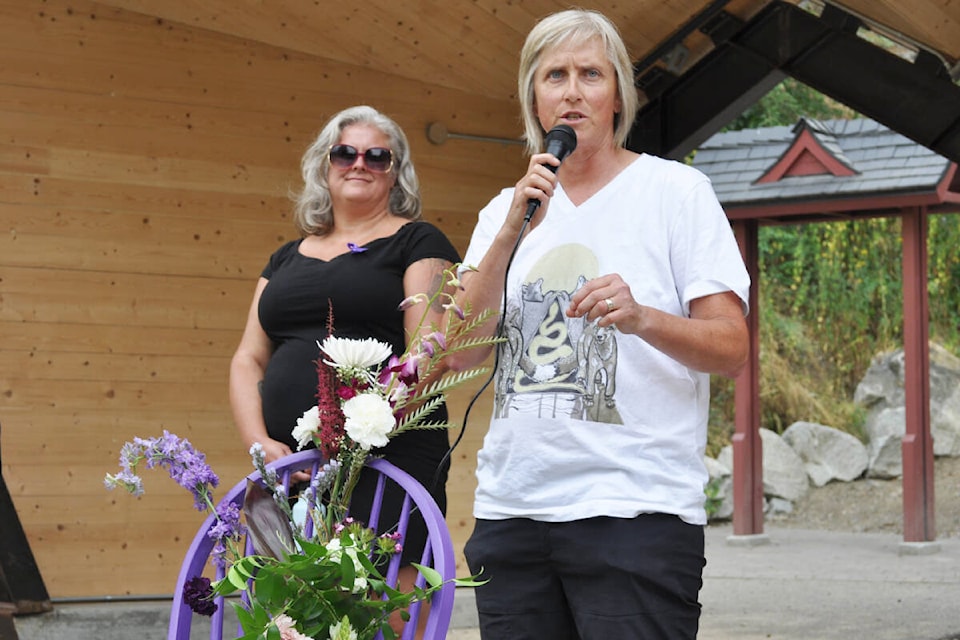Carrie Clark wandered among a small crowd handing out palm-sized pieces of paper. Printed inside each was a picture of her brother Gordie leaning back, hands behind his head, looking happy and at peace.
One year ago to the day, Clark saw her brother for the last time. The family had held an intervention for Gordie, hoping he would get help for substance use disorder.
Clark said she thought Gordie was close to agreeing to get help. But the next day he went to Thunder Bay to attend the funeral of a friend who had died of an overdose.
“He wasn’t there for 24 hours then he died as well,” Clark said through tears. Gordie was 31 years old.
Clark was among Nelson residents who attended a vigil Wednesday at Cottonwood Falls Park to mark International Overdose Awareness Day. In B.C, 10,168 people had died since the toxic drug crisis was declared in 2016. This year, 1,095 people have died in the province, according to the BC Coroners Service.
Even though B.C. remains on track to break another annual record for deaths, local policy makers and emergency officials were notably not in attendance Wednesday.
No one from Nelson city council or Regional District of Central Kootenay attended the vigil, nor were there any uniformed members of the Nelson Police Department, RCMP and Nelson Fire and Rescue present.
Instead, speakers preached to a traumatized choir. Clark said she was disappointed by the turnout and intended to walk around downtown after handing out her pictures of Gordie.
“I just want to shout from the top of the mountain that this is an emergency.”
The only elected official present was Nelson-Creston MLA Brittny Anderson, who said earlier this year a constituent who had previously volunteered making Christmas cards with her staff overdosed in the alley behind Anderson’s Nelson office. The victim survived, but the incident shook Anderson.
“They’re really a good person and we just wanted to make sure that they were OK. Then you extrapolate that out to so many other people in the community that have been impacted or killed due to the toxic drug supply and it’s just absolutely tragic.”
The provincial government’s approach to the drug crisis, which has prioritized expansion of addictions care services and the rollout of pharmaceutical opioids meant to be used as an alternative to street drugs, has been criticized by user groups and harm-reduction advocates.
Even decriminalization measures announced in May have come under scrutiny. When Health Canada announced a three-year pilot that would grant up to 2.5 grams of illicit drugs for personal possession in B.C., advocates said the amount was too little to make any positive impact.
Anderson agreed Wednesday that more needs to be done and suggested the government should consider new ideas. Although she acknowledged being undecided on how safe supply should be approached, Anderson said every B.C. city in need of an overdose prevention site should have one.
ANKORS executive director Cheryl Dowden agreed more overdose prevention sites should be up and running throughout the province. ANKORS manages two overdose prevention sites in Nelson, the only permanent facilities in the West Kootenay, but they aren’t open 24-7 and don’t have proper ventilation required for users who inhale.
“I’m fighting every year to have enough funding to operate our overdose prevention site,” she said. “What we need is a really robust commitment from this provincial government and from the Overdose Emergency Response Centre or from the health authority to fund overdose prevention services.”
Finding local allies has also been difficult for Dowden.
ANKORS runs a pop-up site two days a week in Trail, but has failed to find a permanent home for the service. In Nelson, there’s no supervised site for users who inhale drugs, which would require a specialized tent.
“We just need a place basically and then I think we can go from there. But the challenge is finding that space. It’s got to be compassionate landlord.”
On Wednesday, Vancouver-based Drug Users Liberation Front announced it had provided 30 grams of tested cocaine, heroin and methamphetamine to 15 user groups across B.C.
One of the groups was Nelson’s Kootenay Insurrection for Safe Supply – led by Dylan Griffith, who this week distributed the drugs to residents known as frequent users. The little boxes Griffith handed out each contained 1/10th of a gram inside.
“People didn’t believe it,” he said. “They looked at the boxes and thought it was some kind of joke. And then once they did realize it, they were obviously really happy.”
Opinion differs on the definition of safe supply.
The provincial government considers safe supply to be opioid agonist therapy drugs such as methadone and suboxone, which act as alternatives, but don’t provide the high of street drugs. Advocates such as Griffith believe safe supply should include drugs like heroin that have been tested for fentanyl.
Heroin safe of illicit fentanyl and carfentanil no longer exists in the drug supply, so when Griffith gave it to one person he said she hugged him after using it.
“It’s the first time I’ve ever seen this person look like they’re at peace in any way.”
READ MORE:
• Why you may see purple chairs popping up on International Overdose Awareness Day
• Thousands in B.C. will continue to die until there is a safe drug supply, say advocates
• Advocates say the federal government can do more to address opioid use stigma
• Lack of safe supply and evidence-based care at the core of B.C. drug deaths: report
@tyler_harper | tyler.harper@nelsonstar.com
Like us on Facebook and follow us on Twitter.
